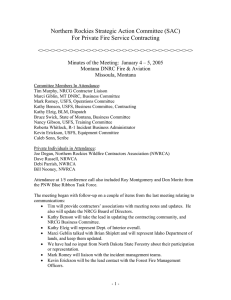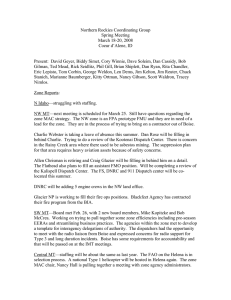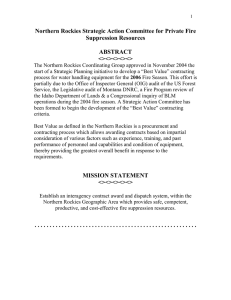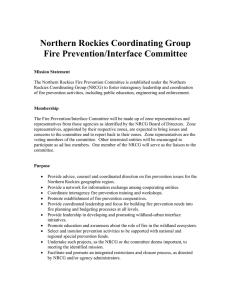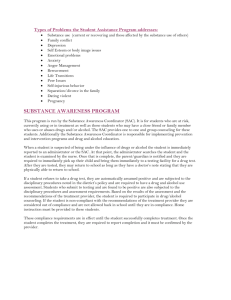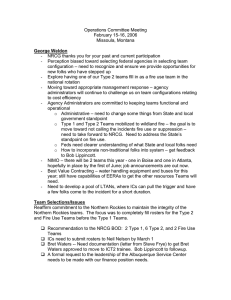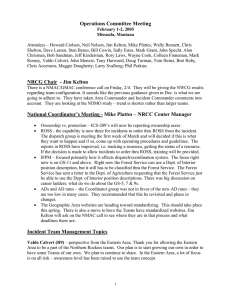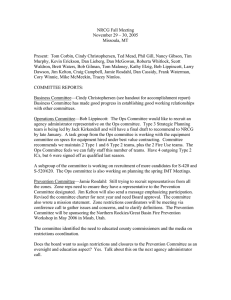Northern Rockies Strategic Action Committee (SAC)
advertisement
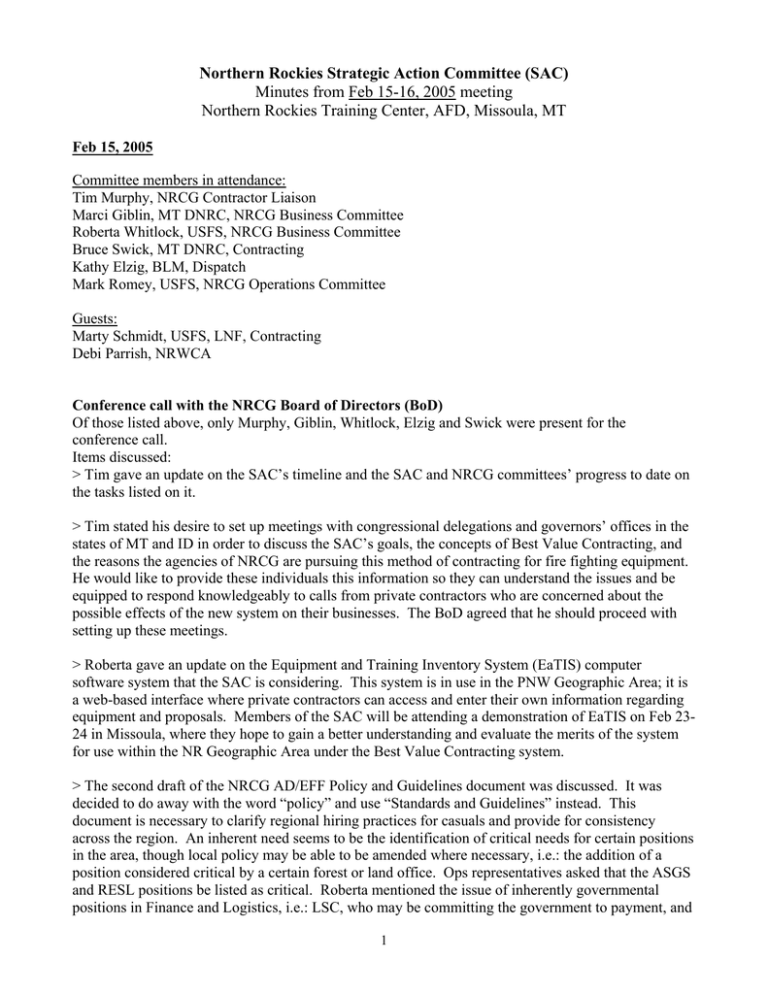
Northern Rockies Strategic Action Committee (SAC) Minutes from Feb 15-16, 2005 meeting Northern Rockies Training Center, AFD, Missoula, MT Feb 15, 2005 Committee members in attendance: Tim Murphy, NRCG Contractor Liaison Marci Giblin, MT DNRC, NRCG Business Committee Roberta Whitlock, USFS, NRCG Business Committee Bruce Swick, MT DNRC, Contracting Kathy Elzig, BLM, Dispatch Mark Romey, USFS, NRCG Operations Committee Guests: Marty Schmidt, USFS, LNF, Contracting Debi Parrish, NRWCA Conference call with the NRCG Board of Directors (BoD) Of those listed above, only Murphy, Giblin, Whitlock, Elzig and Swick were present for the conference call. Items discussed: > Tim gave an update on the SAC’s timeline and the SAC and NRCG committees’ progress to date on the tasks listed on it. > Tim stated his desire to set up meetings with congressional delegations and governors’ offices in the states of MT and ID in order to discuss the SAC’s goals, the concepts of Best Value Contracting, and the reasons the agencies of NRCG are pursuing this method of contracting for fire fighting equipment. He would like to provide these individuals this information so they can understand the issues and be equipped to respond knowledgeably to calls from private contractors who are concerned about the possible effects of the new system on their businesses. The BoD agreed that he should proceed with setting up these meetings. > Roberta gave an update on the Equipment and Training Inventory System (EaTIS) computer software system that the SAC is considering. This system is in use in the PNW Geographic Area; it is a web-based interface where private contractors can access and enter their own information regarding equipment and proposals. Members of the SAC will be attending a demonstration of EaTIS on Feb 2324 in Missoula, where they hope to gain a better understanding and evaluate the merits of the system for use within the NR Geographic Area under the Best Value Contracting system. > The second draft of the NRCG AD/EFF Policy and Guidelines document was discussed. It was decided to do away with the word “policy” and use “Standards and Guidelines” instead. This document is necessary to clarify regional hiring practices for casuals and provide for consistency across the region. An inherent need seems to be the identification of critical needs for certain positions in the area, though local policy may be able to be amended where necessary, i.e.: the addition of a position considered critical by a certain forest or land office. Ops representatives asked that the ASGS and RESL positions be listed as critical. Roberta mentioned the issue of inherently governmental positions in Finance and Logistics, i.e.: LSC, who may be committing the government to payment, and 1 as such, should not be hired as casuals. She will check further into that. A related issue is that of federal / state retirees: they should work with their home dispatch center to be hired, this dispatch center should track and manage their qualifications and issue their red cards. One possibility mentioned is that of contracting out the maintenance of qualification records and the issuance of red cards. Tim asked for agency comments to be submitted to Tracey Nimlos by March 14, 2005. Hope to finalize with Committee in April. National Engine and Crew Contracts Update Tim did the update on the national contracts. Tim & Kevin are both serving on the committee that is looking at these spec’s and contracts. Regions 1, 4, 5, and 6 are the regions represented on the committee, though all regions were invited to participate. The National Crew Contract is 90% done; RFP’s are expected soon and awards in late May. There will be no National Engine Contract, though there will be national engine spec’s that must be followed by regions executing regional engine contracts. These spec’s are 80% done and are expected to be out by May. One issue being discussed by the committee is that of age of equipment. CA, WA, and OR want to place vehicle age limitations ranging from 10 to 16 years in the spec’s. Tim and Kevin are against this idea; they believe the equipment only needs to meet minimum spec’s to be acceptable. Issue is still under discussion. EaTIS Update The EaTIS demonstration will be held on Feb 23-24 at the AFD in the Bob Marshall room. If NRCG / SAC decides to adopt EaTIS, we should expect to incur the $17,000 setup costs this federal Fiscal Year (before Oct 2005) to be split between participating agencies, along with a portion of the $50,000 annual maintenance fee. Business Committee Update Tasks delegated to the NRCG Business Committee from the task timeline: > Define the roles/responsibilities of agency, cooperators, and private contractors under Best Value Contracting. The business committee discussed this topic at length and identified several sub-tasks. It was assigned to the DNRC Business Committee for discussion and to work up a rough draft by 3/1/05 for review and comment by other NRCG committees, local govt, and contractors. > Define “Best Value”. The business committee assigned Bruce Swick to come up with a rough draft definition. The SAC looked at his draft, along with the FAR definition, and the definition the PNWCG is using. The SAC ended up with the following as a working definition; agency legal opinions will be solicited. “Best Value is a procurement and contracting process which allows awarding contracts based on impartial consideration of various factors, such as experience, training, past performance of personnel, and capabilities and condition of equipment, thereby providing the greatest overall benefit in response to the requirement.” > Define the role of EERA’s in the Best Value contracting system. Bertalee Mottern was assigned the lead on this topic. She will work with her contacts and submit a draft for comment and review by 4/1/05. > Define / Agree on Fair Share Administration for costs of Best Value system. Agencies presently involved acknowledge time spent by involved employees but agree not to bill or reimburse each other for now. When costs are more tangible, i.e.: EaTIS setup/maintenance costs, etc, an interagency agreement will have to be reached. Everyone seems to agree that additional help will be needed to 2 administer the Best Value contracts once they are awarded. The federal agencies are unable to assess any kind of surcharge or fee like OR is doing to alleviate the costs of administering its crew contracts. Bruce will check into MT’s options on this. > Investigate state vs. federal contracting legalities. This topic relates specifically to whether, if MT is the lead CO on the BV contracts, the co-signing federal agencies will still be bound by all the federal acquisition regulations they normally contract under. Kathy Benson is checking into this issue from the perspective of the federal agencies. > Develop a scoring system for personnel and equipment. This will be the backbone of the Best Value Contracting system – the various factors and their respective weights to be used in determining the relative value of a piece of contracted equipment. Kathy Benson is putting together a task group to address this issue, with a draft expected by 6/30/05. Suggested members are Kathy, Bruce Swick, Rick Grady, Kevin Erickson, Marty Schmidt, someone from Ops (Edmund Ward was suggested?), and someone from Training ( ? ). Operations Committee Update The following issues are being considered by the Operations Committee: > Performance Evaluations The SAC discussed the Performance Evaluation Crosswalk paper, by David Summers, in which a range of numbers relating to specific criteria are given to help assign a value to performance. The Ops committee agreed with the need to continue using the ICS 224 form, but will consider the crosswalk information as supplementary. The committee is expected to review and comment by 3/30/05. > Identification of the type and numbers of resources needed This task is being addressed by Ops and by Dispatch. Discussion among the SAC centered on whether this information is necessary, and whether we should limit the number of pieces of equipment hired under Best Value Contracting. Conclusion was that, if the work must be done to evaluate the merits of each proposal received and inspect the equipment to verify that it meets the spec’s and the terms of the proposal, then contracts might as well be issued for all equipment that meets the terms. The SAC still feels that the estimated numbers and types of resources that will be needed per dispatch zone will be useful in determining the roles of agency, cooperator, and contractor resources. > Need for performance evaluations The SAC feels that it is critical that performance evaluations on private contractors’ personnel and equipment be obtained during fire season 2005, for use as a best value factor in 2006. In the past, these have not been routinely done for all contractors due to time constraints and the lack of strong direction to Ops personnel. The SAC will request that the NRCG BoD put out a policy paper to member agencies stating that performance evaluations will be required for contracted equipment and personnel, and that this requirement should be clearly stated in Delegations of Authority to IMT’s in 2005. Tim will solicit input from Jeff Scussel, Mike Kopitzke, and Bruce Suenram (current and/or past Planning Section Chiefs) and will then draft a letter to James Kelton, chair of NRCG BoD, outlining this request. > Assistance for contractors in obtaining government contracts This issue arose during the Ops discussion, though it’s not necessarily related to Ops. There is an organization called PTAC (Procurement Technical Assistance Center) that assists private contractors with obtaining government contracts; it helps them through the CCR and DUNS registration process and provides other helpful information and resources. The SAC will include PTAC in the distribution of information regarding SAC’s activities so they can remain updated and help contractors understand the Best Value process; 3 Kathy Benson will be the contact and distribution point since she is already serving in that capacity for the federal CO’s in the region. Montana PTAC contact information: Missoula office (406)728-3337 Teri Wellings (406)532-3207 Kalispell office (406)758-5410 Doug Bolinder Billings office (406)256-6871 Great Falls office (406)454-1934 > Role of EERA’s under Best Value contracting system This task is being addressed by Business and Ops. Discussion at SAC concluded that, under Best Value, EERA’s will not be issued pre-season. All contractors who do not respond to the Request For Proposal, do not meet the minimum spec’s, or otherwise disqualify themselves from the competitive bid process (i.e.: proposal unsigned / incomplete / late, bid over established maximum amount, etc) should be placed on a resource list. If a point is reached where all BV resources in the region are in use, then this list may be utilized for additional equipment and an EERA would be executed at that time. This resource would be replaced with a BV resource as soon as possible. Rates for equipment hired on an EERA have yet to be established, but it is assumed that they would be lower than the average BV price. > Consistent procedures throughout the region The SAC identified a strong need for consistent action among all the NRCG agencies and their individual field offices regarding the BV system and the use of EERA’s. It is highly recommended that internal policy statements be issued within all NRCG member agencies outlining the process to be used to hire contracted equipment in 2006, i.e.: State Forester to DNRC offices, Forest Supervisors to USFS offices, etc. NRCG has agreed to the use of the BV process, but the directives should still come down internally for each agency. Tim will take this topic to the NRCG agency administrator meeting to solicit this cooperation from each agency administrator. Dispatch Update > Identification of number and type of resources needed Kathy Elzig distributed a handout showing the information she pulled from ROSS on the 2003 and 2004 fire seasons. Caveats included the fact that 2003 was the first year ROSS was used here in the region, and that the information represents only Extended Attack and large fires, not IA. She will work to re-format the information to better show specific pieces and numbers of equipment used and will present this at the next meeting. The SAC agreed that the information will be useful to help answer questions on the breakdown of agency, cooperator, and contractor resources used in the past and the respective roles and responsibilities of each. Feb 16, 2005 Present: those listed above as present on Feb 15, and Committee member: Kathy Benson, USFS, Contracting Guest: Dave Russell, NRWCA Open Meeting policy Tim addressed the state of Montana open meeting policy and the federal FACA laws. The interagency SAC meetings fall under both pieces of legislation, and as such, are open to the public; however, it 4 should be understood that non-committee members who choose to attend are not recognized during the proceedings. There will be a public comment period at the end of the meetings for guests to provide their suggestions and comments. There are also public meetings slated for the fall of 2005 to provide the opportunity for all members of the private contracting community and the public at large to comment on the SAC proceedings. The SAC meeting minutes are also posted on the NRCG website. Best Value Factors The SAC has so far identified the following factors for use in determining Best Value: experience and training of personnel past performance condition of equipment capabilities of equipment safety cost See notes from earlier in this meeting regarding formation of task group to work on BV factors and their respective weights. Draft expected by 6/30/05. PNWCG Update – Conference call with Roy Montgomery > The draft performance evaluation crosswalk paper discussed earlier has been accepted by PNWCG and will be implemented in 2005. David Summer will follow through. They have a task group working on building a database to hold the performance evaluations. > The Best Value work group has identified evaluation criteria and is working on a rating process. Don Moritz is the lead on this and a report to PNWCG is expected by mid-March. NRCG and PNWCG should continue to share their progress on this issue in the hope that the two regions can arrive at similar results and be as consistent as possible. > PNW will limit number of contracted resources for 2005 as follows: Crews: 200 NW interagency crews, plus 22 national contract crews assigned within the GACC Engines: 50 contract engines (will increase to 100 in 2006). The contract engines will represent the best values in the region and must guarantee their availability. In return, they will receive dispatch priority to federal incidents. 300 engines under interagency agreements to be awarded under BV criteria. Contractors do not guarantee availability and agency does not guarantee any dispatch priority. Tenders: 250 under interagency agreements > Dispatch work group – considering 5 alternatives and developing details, will bring to PNW in April > Task order guidance document – was out for review by agencies, has been accepted by PNW > Program Management and Contract Administration – They are trying to identify the capability needed to manage the BV program and administer the contracts. Preliminary estimates indicate considerable increases in administration costs, above the level agencies have been able to manage in the past. They are also trying to identify and quantify the hidden costs associated with the process. > IACR position task book work group – The work group will present the draft PTB to PNW in March; they would like to call the position CORNW, to denote that the Contracting Officer’s Representative is a regional affiliation. 5 Fair Share Administration This issue relates to the costs of establishing and implementing the BV contracting system and the question of how to equitably share these costs among all the NRCG agencies. There is also the issue of hidden costs, or those that are not easily traced, that directly or indirectly contribute to the success of the endeavor. The NRCG committee members who also belong to SAC already have their supervisor’s approval to commit time to NRCG issues, but the SAC activities will require more and more investment of time as we get further down the road. We will continue to study and discuss this issue. Next meeting The SAC agreed that perhaps we don’t need a full 2-day meeting next month since the most immediate tasks have been delegated out to various individuals and NRCG committees. We will plan on a conference call on 3/31/05, from 9:00 am to 12:00 noon. The April meeting is still scheduled for the 19th and 20th in the Missouri Room at the AFD in Missoula. Public Comment Debi Parrish and Dave Russell, from the Northern Rockies Wildfire Contractors’ Association (NRWCA) distributed a position paper their association had prepared after the last meeting in January. Two points were brought up: 1. Emphasize the importance of performance evaluations in the BV contracting system. The SAC concurs with this and is actively seeking to make performance evaluations a critical factor of Best Value, as noted in the minutes of this meeting and past meetings. One concern is not holding it against those contractors who never received performance evaluations in the past, or those who are new to the business. The SAC would like to make the lack of past evaluations a neutral point that counts neither for or against a contractor, while still rewarding those contractors who have positive evaluations of past performance and recognizing their proven value. The NRCG member agencies recognize this as an internal issue; that evaluations have not been required or routinely done in the past. It will take internal training and direction to get the word out to line officers about the importance of doing evaluations in the coming seasons. This point and a related course of action is addressed earlier in these minutes. 2. Concern over the state of MT being the lead CO for the Best Value contracts, leading to confusion between private, state, and federal agencies. NRWCA states that they have contacted numerous federal CO’s who have the same concerns. NRWCA recommends that each zone be responsible for their own BV RFP’s. Concern over duplication of a system the FS presently has in place. The SAC notes that the federal CO’s have been contacted and their concerns should have been addressed since the writing of this NRWCA paper after the January meeting. Any CO’s with additional concerns should contact Tim Murphy or Kathy Benson for a full discussion to address their questions. As currently anticipated, MT DNRC will be primarily responsible for putting together the draft Request For Proposal and soliciting input from concerned parties. The state and federal agencies will jointly agree on the final document, then the DNRC will distribute and receive proposals. Proposals will be evaluated and rated by an interagency evaluation committee. As to the duplication of a system already in place, the Best Value process for contracting of water handling equipment will not be duplicating the present EERA system of established rates; it will be 6 replacing it with a competitive bid system where incentives exist to increase quality of the service provided. Rates should reflect quality. It is important to note here that one of the many reasons for going to the Best Value contracting system is the widely recognized need for consistency in contracting and procurement practices across the region and between all the agencies. The SAC and the NRCG feel that the Best Value system will address that need for consistency by having an interagency committee plan and implement the system on a regional, rather than local, level. Individual field offices will receive internal direction that requires them to abide by the terms of the contract. It also should be noted that when the contracted resources are ordered and assigned to an incident, the contracts will be administered “on the ground” by the incident agency. NRCG is working to increase the numbers and update the training of the COTR and/or COR positions in the region in order to have people available who can assist in the proper administration of these contracts in a consistent manner across the region. NRWCA notes that they will be preparing another position paper addressing their concerns on contracting of local government forces under the Best Value system for submission at the next meeting. 7 Addendum to SAC Feb 2005 meeting minutes – EaTIS demo Feb 23, 2005 Several members of the SAC attended a demonstration of the Equipment and Training Inventory System (EaTIS) put on by Terry Brown, USFS, PNWCG, Region 6. Present: Tim Murphy, Marci Giblin, Roberta Whitlock, Bruce Swick, Kevin Erickson, Kathy Elzig Relevant aspects of the PNWCG system already in place: > Government establishes a maximum “fair and reasonable” daily rate for each type of equipment. This is based on 125% of the average of the bids received. Bids over this amount are given the opportunity to revise bid rate. > The inspection process is contracted out; there is one vendor in OR and one in WA that performs the inspections. Government pays a flat rate. Contractors pay $150 per inspection; if they fail the first one, there is no cost at that time. If they return for a re-inspection, there is a re-inspection fee of $75. If they pass the re-inspection, then they must pay the $150 plus the $75. > There are equipment factors above the minimum spec’s that determine dispatch priority, i.e.: For engines: age of vehicle, 4-wheel drive, foam system, and mechanical condition. These factors are scored and taken into account with the bid price to come up with an adjusted rating in a dispatch table. Resources are dispatched in order of their rating in this table. EaTIS > EaTIS allows contractors to enter their own information on equipment and personnel in a userfriendly web-based system that is also accessed by agency staff and equipment inspectors. Each person accessing the system has a unique user ID and password. > There are security measures in place that control access to data and track all changes made, i.e.: After the bid is closed, contractors can not change any of their equipment information on their own; they must request a change through the agency, which is tracked. When they go to print an agreement, the CO’s electronic signature will not print until the contractor has electronically signed the agreement also. > Equipment inspectors enter inspection scores and information on mechanical condition directly into the system. Inspectors’ access is limited to only what they need to see to accomplish this. They cannot see information such as company tax ID# or employee records. > Information on equipment and ratings for dispatch priority are automatically sorted into tables for each dispatch center based on zip codes of equipment location. > Various reports are available to track and sort data within the system. > Eventually, it is hoped that EaTIS can be linked with ROSS, ICS/ISUITE, and payment centers so that all the information between equipment sign-up and payment only has to be entered once. Currently, it must be entered separately as many as 5 or 6 times during this timeframe, which allows a large potential for error in data entry. > The projected costs for NRCG use of EaTIS are less than previously reported. It would require payment of a portion of the annual maintenance fee of $50,000 currently born by R6 to maintain the server in Kansas City. This amount would conceivably go down if/when more regions buy in. NRCG would also have to pay a programmer to modify the system somewhat for its unique needs; a rough estimate is $10,000 to $15,000 for initial setup. 8 SAC discussion on EaTIS Everyone present agreed on the merits of the system. It will increase efficiencies on several levels throughout the contracting and procurement process and save CO’s and related staff an enormous amount of work. The security measures, safeguards, and access limits are all well thought-out and appropriate to the application. It appears to be very intuitive and easy to navigate around in, and the PNW has put together a clearly written instruction booklet for contractors. The SAC members present strongly recommend that the NRCG pursue the use of EaTIS within the Best Value contracting system. As to the issue of funding, it is recommended that NRCG allocate funding responsibilities much like the funding of Tim Murphy’s position, where the agencies each pay a portion based on their share of the large fire business over a 10-year moving average. Tim will take this suggestion to the NRCG BoD. It is anticipated that funding needs will occur in Fiscal Year 06. Tim will request an initial funding authorization of $40,000 to cover initial setup and the first year’s maintenance. 9
